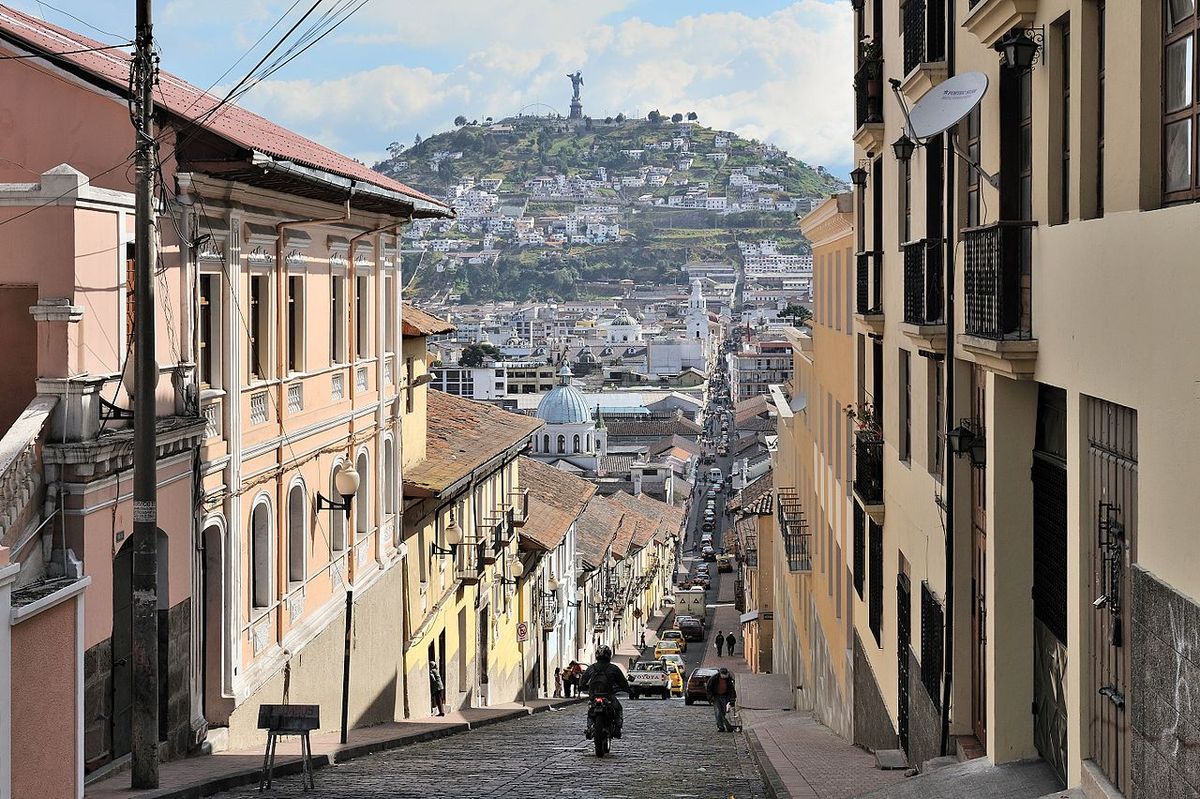About
Calle García Moreno is one of the oldest streets in Quito. Following the route of what was once a sacred Inca path, it is now known by two names: one referring to the Catholic crosses built along the street, and the other to the president assassinated on it.
The initial urban development of colonial Quito (founded in 1534) posed a few problems for the Spanish conquistadors. Crisscrossed by creeks and ravines, and with a range of different elevations, it wasn’t easy for the Spanish town planners to lay out the classic grid plan that defines so many colonial towns and cities in the Americas.
To create a semblance of order, they filled in many ravines. Along these ravines ran a sacred Inca path, connecting two temples: Yavirag, dedicated to Inti (the Inca sun god) and located atop El Panecillo Hill to the south of the city center, and Hunacauri, dedicated to Mama Quilla (the Inca goddess of the moon) on the hill of San Juan to the north.
Once the filling-in was complete, the Spanish created one of the city’s first streets along the old sacred route. And, as they were prone to do, they soon started building Catholic churches along its course to better convert the indigenous population.
By the end of the 16th century, some of the churches and chapels had erected stone crosses in the street to serve as public altars during the popular Corpus Christi celebrations each year. The crosses also served as a constant reminder to the city’s Spanish, mestizo, and indigenous faithful to not forget their religion as they ate—and often drank—in the cantinas and bars of the well-trodden street.
Seven stone crosses were erected in total, and the street became known as Calle de las Siete Cruces (Street of the Seven Crosses), a name that can still be seen on street signs to this day. Officially, however, the street was renamed Calle García Moreno at the end of the 19th century in honor of the Ecuadorian president who was assassinated along its route.
The piously conservative García Moreno had served as president of Ecuador twice in the latter half of the 19th century. He was a tough man, some would say a dictator, and he had his enemies. Liberals hated Moreno, both for his policies and his use of secret police to silence dissenting voices. Groups such as the Freemasons also had him in their sights, as he had outlawed secret societies of all forms. He made Catholicism the state religion and the only legal faith in Ecuador, and gave power to the church the likes of which it never had before, or has since.
The third time García Moreno was elected, in 1875, even he seemed to know his days were numbered. He sent a letter to the pope asking for his blessing and protection before his inauguration day. In it he wrote:
“Now that the Masonic Lodges of the neighboring countries, instigated by Germany, are vomiting against me all sorts of atrocious insults and horrible calumnies, now that the Lodges are secretly arranging for my assassination, I have more need than ever of the divine protection so that I may live and die in defense of our holy religion and the beloved republic which I am called once more to rule.”
In the end, an appeal for divine protection wasn’t enough to keep Moreno out of harm’s way. On August 6, 1875, Faustino Rayo attacked the president on the steps of the Palacio de Carondelet, on Calle de las Siete Cruces. He struck the president with several blows from his machete, after which three or four of his co-assassins fired their revolvers upon the stricken president.
Despite being a man who inspired more fear than love, the street was nevertheless renamed in honor of the murdered president, and has to this day borne the name of García Moreno. A plaque on the walls of the Palacio de Carondelet marks the spot where he was murdered—just one of many interesting details along Calle García Moreno, apart from the seven crosses.
Related Tags
Know Before You Go
Calle García Moreno runs for just under a mile through the historic center of Quito, between Julio Matovelle in the San Juan neighborhood to the north and Ambato in the San Roque neighborhood to the south. The crosses are found, from north to south, at the Iglesia de Santa Bárbara, La Concepción, La Catedral, El Sagrario, La Compañía, the Iglesia de El Carmen Alto, and finally the Hospital Psiquiátrico San Lázaro. Roughly at its midpoint, the street passes along one side of the Plaza Grande.
Wild Galapagos: An Ecological Wonderland
Darwin's legacy, snorkeling, volcanic landscapes & conservation insights.
Book NowCommunity Contributors
Added By
Published
April 19, 2019
Sources
- https://static1.squarespace.com/static/54f886f6e4b0e9aec8275c0d/t/583de6251b631b930034032e/1480451639171/70+-+trabajo+-+La+calle+de+las+siete+cruces.pdf
- https://www.goraymi.com/es-ec/quito/las-siete-cruces-del-centro-historico-de-quito-a2471a39d
- https://www.tfp.org/garcia-moreno-heroic-president-of-ecuador/








































